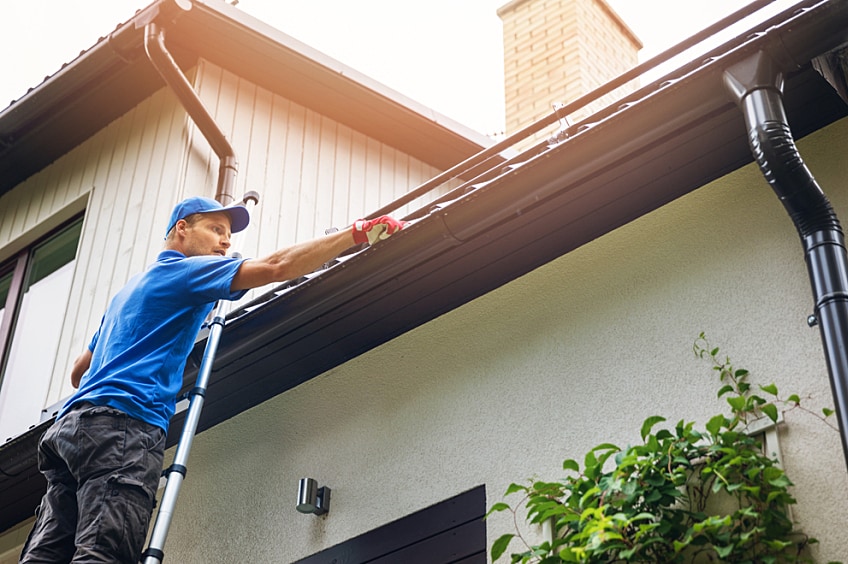Storm preparedness involves more than just stocking up on supplies; it requires proactive measures to protect your home from potential damage. One crucial but often overlooked aspect of preparation is maintaining your roof and gutters. Regular maintenance can make the difference between weathering a storm with minimal impact and facing costly repairs. Roof cleaning Mt Pleasant services from Charleston Gutter Solutions play a vital role in keeping homes storm-ready by ensuring that roofs and gutters are clean and functioning efficiently.
Clearing Drainage Paths: Ensuring Gutters Can Handle Heavy Rain
A primary function of gutters is to direct rainwater away from your home, preventing water from pooling around the foundation or seeping into walls. However, clogged gutters can lead to a host of problems during heavy storms.Which is why gutter cleaning is important to get done.
- Preventing Water Overflow: Leaves, twigs, and debris can block gutters, causing water to overflow. This overflow can damage siding, erode landscaping, and even lead to structural issues in your home’s foundation. Clearing these blockages ensures water flows smoothly and minimizes the risk of costly repairs.
- Reducing Roof Damage: Blocked gutters can trap water, leading to standing pools on your roof. Over time, this can weaken shingles, increase the risk of leaks, and accelerate roof deterioration. Ensuring that gutters are free from debris protects the structural integrity of your roof.
- Protecting Interior Spaces: Properly functioning gutters reduce the chances of water intrusion into your home, which can cause mold growth, wood rot, and other costly damages. Addressing these issues before a storm provides peace of mind and reduces the risk of internal damage.
Removing Weak Branches: Preventing Roof Damage from Falling Debris
Overhanging tree branches may add charm to your property, but they pose significant risks during storms. High winds and heavy rain can easily break weak or dead branches, turning them into dangerous projectiles.
- Identifying Problematic Branches: Routine inspections can help identify branches that are too close to the roof or are visibly weak. These branches can easily fall during storms, causing punctures, dents, or other serious roof damage. Addressing these risks in advance can save you from expensive repairs.
- Protecting Gutters: Branches and other debris can also clog gutters during a storm. Clogged gutters exacerbate water overflow issues, which can lead to damage both to your home’s exterior and interior. Removing potential debris sources is a proactive way to prevent these problems.
- Improving Tree Health: Pruning trees not only prevents storm-related hazards but also promotes healthy growth. This ensures that trees remain strong and resilient, reducing the likelihood of future weak branches and maintaining the overall safety of your property.
Inspecting for Damage: Identifying Weak Spots Before Storms Hit
A roof inspection is a critical step in storm preparedness. Identifying and addressing vulnerabilities before a storm hits can save you from extensive damage and expensive repairs.
- Spotting Loose Shingles: Strong winds can easily lift loose shingles, exposing your roof to water damage. Regular inspections allow you to identify and secure these shingles, preventing potential leaks and water intrusion.
- Checking Flashing and Seals: Areas around chimneys, vents, and skylights are particularly vulnerable to leaks. Your property might be at risk of water damage if the flashing is damaged or not built correctly. Ensuring these areas are secure helps maintain a watertight roof.
- Evaluating Structural Integrity: Cracks, sagging areas, or signs of rot can indicate deeper structural issues. Ignoring these signs can lead to catastrophic roof failures during storms. Proactively addressing these concerns ensures that your roof remains a reliable barrier against severe weather.
Emergency Readiness: Creating a Maintenance Plan for Post-Storm Cleanup
While pre-storm preparations are essential, having a plan for post-storm cleanup ensures that any damage is addressed promptly and effectively.
- Documenting Pre-Storm Condition: Taking photos of your roof and gutters before a storm provides a baseline for assessing damage. This documentation is invaluable when filing insurance claims, as it clearly shows the storm’s impact.
- Prioritizing Immediate Repairs: After a storm, addressing critical damage such as leaks or broken shingles should be the top priority. Delaying repairs can lead to further deterioration and higher repair costs over time.
- Scheduling Professional Services: Storms often leave behind debris that can block gutters or damage roofing materials. Professional cleaning and repair services ensure that your roof and gutters are restored to optimal condition quickly and safely.
- Planning Preventative Measures: Post-storm cleanup is an opportunity to evaluate what worked and what didn’t in your preparedness plan. Use this time to schedule routine maintenance and make necessary upgrades, such as installing gutter guards or reinforcing vulnerable areas of your roof.
Conclusion
Storm preparedness is a continuous process that involves proactive roof and gutter maintenance. From clearing drainage paths to inspecting for vulnerabilities, each step plays a vital role in protecting your home from storm damage. For homeowners, professional roof and gutter cleaning services ensure that your property remains resilient and ready to face adverse weather conditions. Don’t wait for the next storm to expose weaknesses—invest in regular maintenance and enjoy the peace of mind that comes with a well-protected home.






